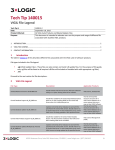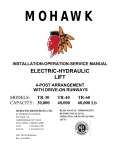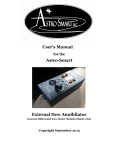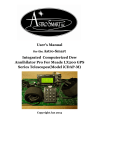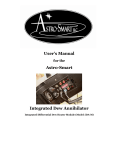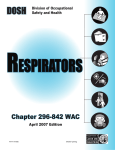Download Technician - Work of Honor
Transcript
Technician Job Summary: The Technician will be directly responsible for the repair and diagnosis of incoming vehicles in a professional and timely manner. Responsibilities to Include: • Perform all work as designated on repair orders. • Inform service advisor if additional work is needed. • Assist in training and supervising of apprentices/T-‐10 students (when applicable). • Attend all training sessions and meetings. • Maintain a neat and orderly work area. • Obey all company, OSHA, WISHA, environmental and other rules, regulations, and automotive laws. • Diagnose customer vehicles and repair as needed. • Properly describe cause and cure on every finished repair order. • Responsible for quality of workmanship. Test drive before and after completion of repairs as needed. • Understand that diagnosis time is included in most operation times. • Inform dispatch or service advisor of any delays in which the promised time cannot be met. • Escalate any “did not duplicate” to the shop lead, dispatch, diagnostic specialist or service manager. • Return all spent parts in bin to the parts department upon completion. Areas of Specialization: • Air Conditioning System: Install air conditioners, know how to service and repair all components of the refrigeration system. • Manual Transmission and Clutch System: Knows how to diagnose and repair all components of the clutch and manual transmission system. • Automatic Transmission/Transaxle System: Has thorough knowledge of all parts of the automatic transmission system and theory on which it operates, performs special tests that check performance, repairs and replaces linkage, gear trains, hydraulic, electronic, and other parts of the automatic transmission. • Brake System/ABS System: Knows how to service and is experienced in all minor and major brake repairs. • Accessories Installation: Know how to install all special factory-‐offered accessories. • Electrical Diagnosis and Repair: Has thorough knowledge to use all industry electrical diagnostic equipment. Knows how to diagnose all electrical components and perform needed repairs. • Heavy Duty Engine Repairs: Knows how to diagnose and repair all external and internal engine parts including complete overhauls. Has thorough knowledge of the emissions systems. • Runability Diagnosis and Repairs: Has completed training in runability systems. Works with specialized equipment to discover cause of engine, fuel system, or electrical/computer problems. Knows how to diagnose or to repair all emission systems. Follows all local and federal emission laws and regulations. • Front End/Steering Systems: Knows how to operate front end alignment equipment. Knows how to balance wheels, align front ends (4 ways). Knows how to diagnose and repair front end steering systems as per manufacturers specifications and recommendations. • Rear End: Has thorough knowledge of all parts of the rear end/differential system. Has the ability to diagnose problems and repair as needed. • General Repairs and Services: Takes care of minor body adjustments, tune ups, other services, LOF’s radiator service, water leaks, squeaks, and rattles. • Perform other duties as assigned by management. • Regular attendance is essential. • Work in cooperative, positive & professional manner with all personnel in the company. • Treat members of the public and customers in a courteous and non-‐discriminatory manner. Maintain professional demeanor while at work. • Must conform to company policy regarding non-‐discrimination and harassment. Page 1 of 3 ______ (Please Initial above) 1 Technician Equipment/Machines/Tools Typically Used: Hydraulic or electric hoists, hydraulic jacks, engine hoists, jack stands, brake lathes, mechanical or hydraulic presses, drill press, tire servicing equipment, grinders, electric or gas welding equipment, diagnostic equipment, hand and air tools, and measuring tools. Hearing protection as required, face shield, clear goggles, welding goggles, respirators, face masks, and appropriate shoes. Chemicals: Numerous chemicals are used/handled on a frequent basis. Employee will be trained by their supervisor on the safe handling/use of these substances. Employee will follow all safety directives at all times. Physical Demands: Intermittent standing, walking, sitting, stooping, kneeling, and crouching; lifting 50 lbs or less on frequent basis and carrying 25 lbs or less on frequent basis; frequent pushing, pulling, twisting and turning of trunk, reaching and handling of objects; occasional climbing, balancing, and crawling. This is not necessarily an exhaustive list of responsibilities, skills, duties, requirements, efforts, or working conditions associated with the job. While this list is intended to be an accurate reflection of the current job, the Dealership reserves the right to revise the functions and duties of the job or to require that additional or different tasks be performed when circumstances change (i.e., emergencies, changes in personnel, work load, rush jobs, or technological developments). I have carefully read and understand the contents of this job description. I understand the responsibilities, requirements and duties expected of me. I also understand that this job description does not constitute a contract of employment nor alter my status as an at-‐will employee. I have the right to terminate my employment at any time and for any reason, and the Dealership has a similar right. We are an Equal Opportunity Employer. Tool Waiver – Read Carefully Sonitrol provides security protection services for our dealership. Sonitrol’s unique system provides a high level of credibility with law enforcement coupled with a rapid and informed response. It is agreed and understood that the Dealership assumes no responsibility for loss or damage to your tools or other personal property by fire, theft, accident or any other cause. Your signature below acknowledges your full understanding and acceptance or your responsibility for maintaining full insurance on said tools and personal property. Vehicle Hoist Use & Inspections Lifting Vehicle Safely All employees at any dealerships within the O’Brien Auto Group who perform duties requiring the use of a vehicle hoist will be thoroughly instructed in the safe use and specific operating procedures for each of the types of hoist that he/she may be expected to use. Employees are NOT to use hoists if they have not had specific training on that particular hoist. All hoists will be inspected daily by the technician who will be using the hoist. Any employee (at any time) who notices any discrepancy or operation malfunction with a Hoist is to report it immediately to their supervisor. If the hoist is determined to be unsafe it will be tagged as “Out of Service”, and not used until repaired. Vehicles that are to be lifted will be lifted at proper lifting points. The use of factory lift foot extensions will be used for frames of differing height. At no time will “blocks of wood” or other modification objects be used to support the vehicle to be lifted. Further; at no time will alterations or modifications be allowed on any hoist. This means that operational controls such as safety latches MAY NOT be altered or modified in any way as to prevent their proper use when vehicles are raised. Training: The Law of Gravity is based upon the assumption that what goes up eventually must come down. Hopefully, when you want it to (and not before). Lifting the customers’ vehicle may well be the most dangerous job you will perform! The consequences if done incorrectly may be fatal. Page 2 of 3 _______ (Please initial above) 2 Technician Therefore it is essential that you fully understand the operating procedures for the specific hoist(s) you will use and follow all established safety procedures. • Only trained personnel shall be authorized to operate the vehicle lift. • If the lift is not working properly or is damaged; DO NOT OPERATE THE LIFT. Notify your manager immediately. • Before bringing a vehicle onto or into the lift area, have the area free of o Grease and oil o Tools o Cords and hoses o Trash and any other debris • Customers or other bystanders should not be in the lift area. Do not allow anyone to ride on the lift or in the vehicle when raising or lowering the vehicle. Inspect your lift daily. Never operate if it malfunctions or if it has broken or damaged parts. Repairs should be made with original equipment parts. • Operating controls are designed to close when released. Do not block open or override them. • Never overload your lift. Manufacturer’s rated capacity is shown on nameplate affixed to the lift. • Only trained and authorized personnel should do positioning of vehicle and operation of the lift. • Never raise vehicle with anyone inside it. Customers or by-‐standers should not be in the lift area during operation. • Always keep the lift area free of obstructions, grease, oil, trash and other debris. • Before driving vehicle over lift, position arms and supports to provide unobstructed clearance. Do not hit or run over lift arms, adapters, or axle supports. This could damage lift or vehicle. • Load vehicle on lift carefully. Position lift supports to contact at the vehicle manufacturer’s recommended lifting points. Raise lift until supports contact vehicle. Check supports for secure contact with vehicle. Raise lift to desired working height. CAUTION: If you are working under vehicle, lift should be raised high enough for locking device to be engaged. NEVER work under a lift with out safety latches engaged. • Note that with some vehicles, the removal (or installation) of components may cause a critical shift in the center of gravity, and result in raised vehicle instability. Refer to the vehicle manufacturer’s service manual for recommended procedures when vehicle components are removed. • Before lowering lift, be sure tool trays, stands, etc. are removed from under vehicle. Release locking devices before attempting to lower lift. • Lifts should always be attended while vehicles are raised or lowered. • Before removing vehicle from lift area, position lift arms and supports to provide an unobstructed exit. NOTE: When using a frame engaging lift, it is very important that the vehicle be lifted using manufactures recommended lifting points. If you are in doubt about proper lifting points to use, ASK YOUR MANAGER. The Automotive Lift Institute (ALI) has a manual that indicates proper lifting points for domestic and imported cars and light trucks. This manual may be purchased (last cost was $5.00) at the following address. Automotive Lift Institute PO Box 33116 Indialantic, FL 32903-‐3116 Vehicle Hoists Inspection Report All hoists at this facility will be routinely inspected daily by the technician assigned to that hoist. Inspection will consist of a visual and operational “quick check” of the hoist. Any discrepancies will be reported to management immediately. If a hoist has a serious discrepancy, the hoist will be taken out of service until an authorized contractor has serviced and repaired the hoist. In addition, all hoists at this facility will receive yearly, thorough inspections by management or authorized independent contractor. The inspections will be documented. I have received, read and understand the company’s “Vehicle Hoist Use and Inspections” program and will abide by the rules as printed. If I have any questions I will ask my manager immediately. I will not modify or change my hoist controls at any time. Any discrepancies or working problems with my hoist will be reported immediately to my manager. Employee Signature Date Employee Printed Name • 3 Technician



